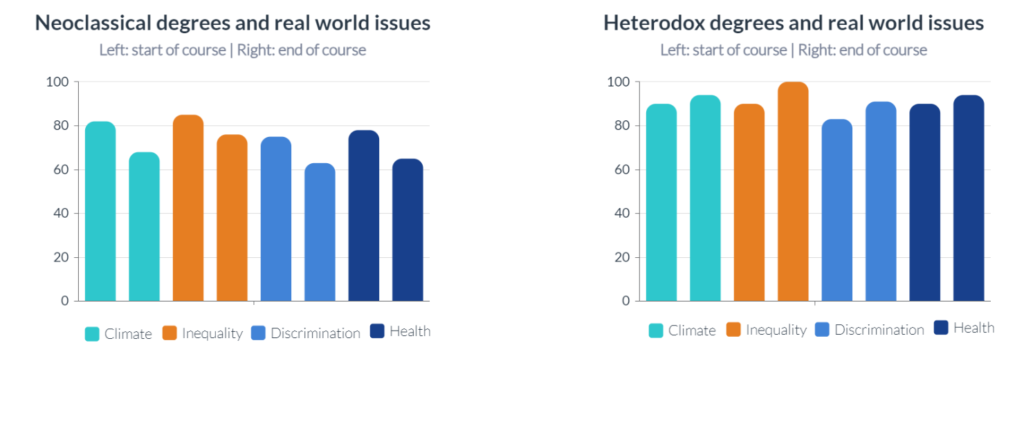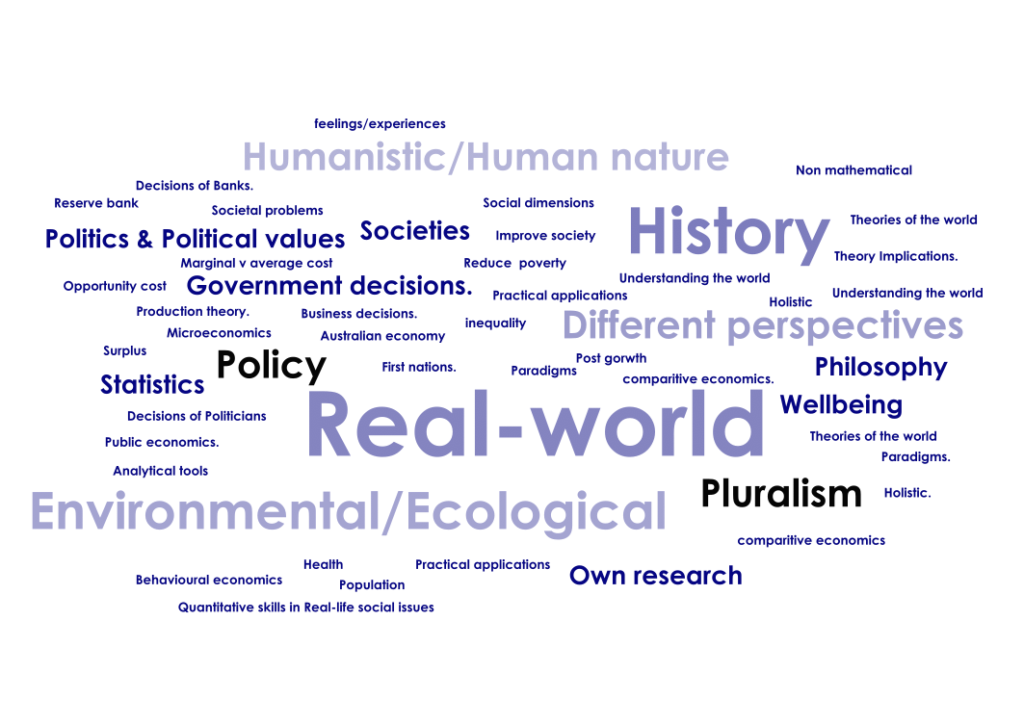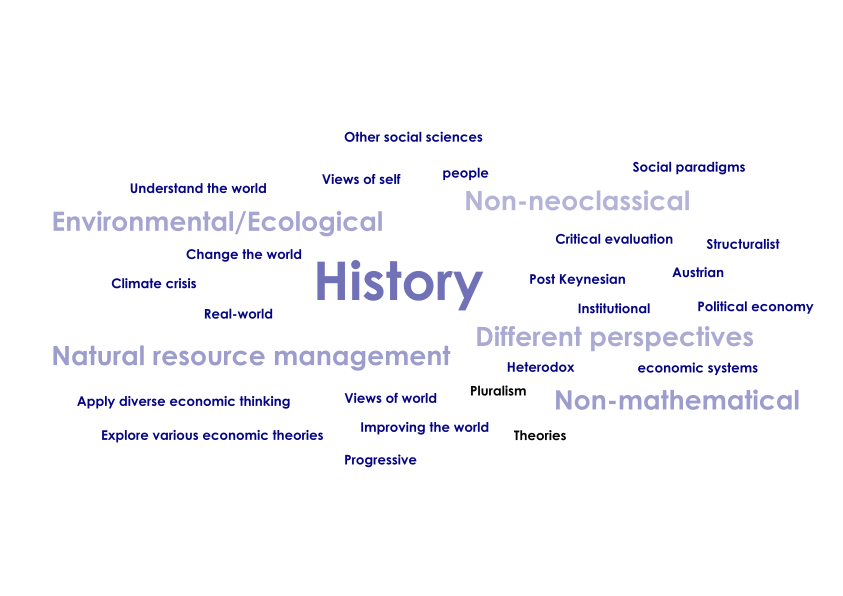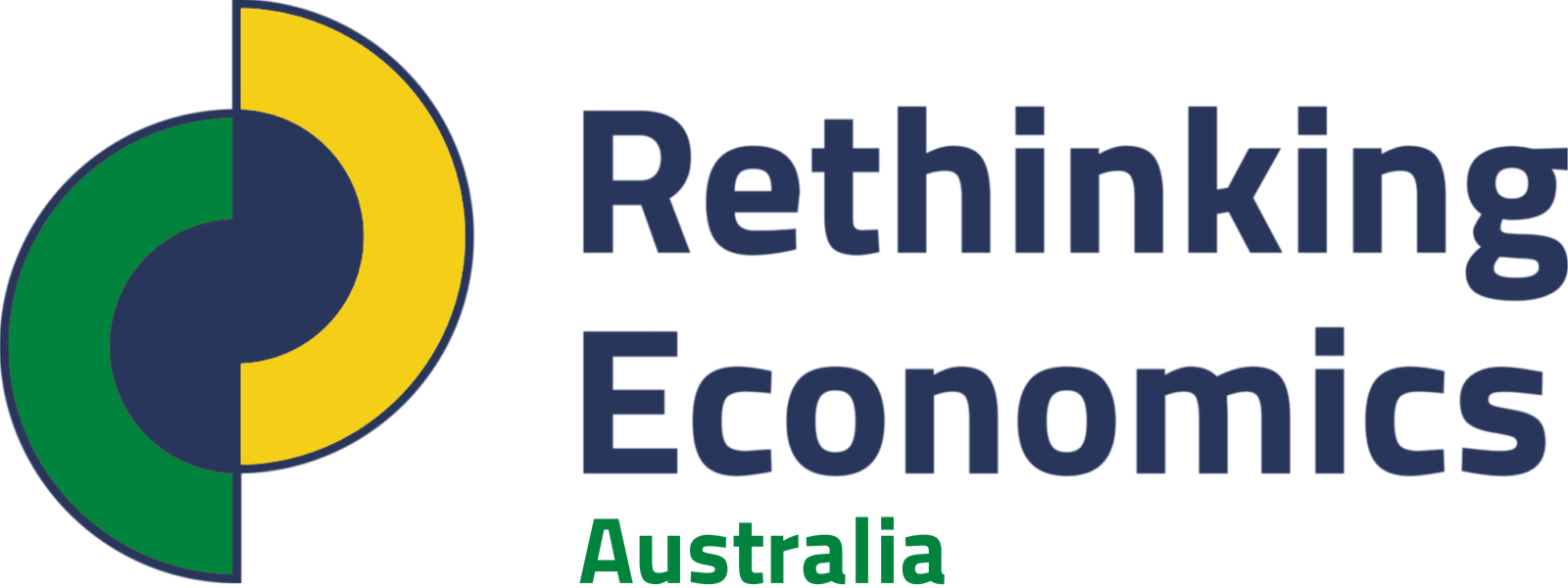RESEARCH SURVEY REPORT
Economics Students and the Australian Economics Curriculum
Reported on 1 July 2023
Report Compiled by: Dennis Venter
This report outlines the results of an economics curriculum survey conducted by Rethinking Economics Australia (REA). The survey aimed to study student sentiment toward the state of the economics curriculum in Australia and direct further study into the curriculum.
Key Findings
- The survey revealed a strong preference for non-neoclassical economics among Australian students.
- Student satisfaction with mainstream economics courses deteriorates as these courses progress. Students enrolled in courses with a focus on heterodox schools of thought, political economy, and ecological economics maintain a high level of satisfaction throughout.
- When asked to comment on what parts of their economics courses students are unsatisfied with, 70% of comments referred to unrealistic assumptions, mathematical equations which do not apply to the real world, and a lack of learning about environmental issues and history.
- A cornerstone finding of this survey is that the extent to which a mainstream economics student agrees with the term “Mainstream economics is detached from the real world” is lower in new students, increases in students who are roughly midway through their undergraduate degree, and is high in students who have or are about to graduate.
– Our video presentation of the results.
1. Introduction
From the survey launch date (1 November 2022) and the date of compiling this report (1 July 2023), 60 responses have been received. Responses were filtered to only consider those who were currently studying or have graduated from an economics course at an Australian university or tertiary educational institution. 54 such responses were received.
1.1 Survey Design
Respondents were asked to indicate their course, their university, and the progress of their course. This meant that responses could be analysed according to whether the student were doing a course with a predominant focus on neoclassical economics or a course that had a big focus on heterodox economics schools of thought such as political economy or ecological-environmental economics. Responses could also be subdivided between those who were around the middle of their course and those who have graduated (or soon will). The reason for this design choice was to determine if there were material differences in sentiment between these subgroups.
The rest of the survey consisted of questions that asked respondents to rate their agreement with certain phrases on a 5-point scale and to provide comments on certain parts of their course. All 5-point scale responses have been multiplied by 25 in order to get a number on a 100-point scale for ease of graphing.
1.2 Survey Promotion
The survey has been shared by lecturers during classes, posted in university newsletters, promoted on posters on university notice boards, and shared on social media pages of university and other educational institutions.
1.3 Respondents’ Overview
Of the 54 respondents, 41 were enrolled in a degree with a predominantly neoclassical focus while 13 were enrolled in a degree with a large heterodox focus.

With regards to the progress of their courses, 3 were at the start of their studies, 28 were around midway, and 23 were either about to complete or have completed their course. 31 of the respondents were male, 20 were female, and 2 were other.
2. Findings
Students were asked to what extent their degree was meeting their expectations. The results are summarised in table 1.

On average, there was no change in how well heterodox degrees met student expectations, courses with a neoclassical focus dropped by 16 percentage points. At the end of their studies, neoclassical economics students’ expectations have only been met by 58%.
Students were asked to what extent their course prepares them for a range of real-world economic issues such as the climate crisis, inequality, discrimination, and the health crisis. The two charts below indicate the extent to which students in their respective course types agreed that their course was preparing them for these issues. Each topic has two bars, indicating responses from students at the start and end of their course. Useful averages are also provided in Table 2.


On average, degrees with a heterodox orientation scored higher, there was a slight increase between the start and end of these courses, possibly due to the reason that these deal with more mainstream approaches in the first year and introduce more heterodox approaches that deal with the above topics during third year.
In neoclassically orientated degrees, we see a drop in how well students think their degrees could address these topics. This corresponds to the drop in how well a neoclassically orientated degree meets students’ expectations. This might propose a reason for the latter.
As many degrees are mixed to a certain extent and at least some heterodox perspectives have made their way into mainstream degrees, asking a student how well their course was meeting their expectations on a number scale only reveals a partial picture. Therefore, this was supplemented by providing space for respondents to comment on which parts of their course they were finding helpful and satisfactory and which parts they did not. The number scale provides useful averages while the commentaries provide deeper insight.
Below are the most common words (by font size) used to describe what neoclassical economics students (top) and heterodox economics students (bottom) found helpful and wanted to see more of in their courses.


As can be seen, both word-clouds are quite similar. It would seem that some of the satisfaction resulting from mainstream courses is not due to mainstream methods but rather thanks to the small amount of heterodox elements that made their way into these courses.
When students were asked what they did not find helpful about their degrees, 70% of comments referred to mathematics which is not applicable to real-world issues, unrealistic assumptions, and a lack of learning about history and environmental issues.
When it came to studying economics, it thus seemed that preferences were similar, regardless of whether a student was doing a neoclassical or a heterodox degree. The only difference was that heterodox students experienced more of the former while neoclassical students experienced more of the latter. This explains the difference in satisfaction ratings.
Students were then asked to what extent they agree with the phrase “Mainstream economics is detached from the real world”. As expected, all students enrolled in courses with a heterodox focus agreed with this statement 100% regardless of whether they were at the start or end of their course. When neoclassical economics students were asked the same question, they agreed with this phrase 63% at the start and 71% at the end of their course.
Therefore, there was a common belief among students, regardless of whether they were enrolled in neoclassical or heterodox courses, that mainstream economics is detached from the real world. This belief becomes stronger as neoclassical economics students progress in their education and remains strong in heterodox students throughout their course of studies.
3. Other Comments
A deeper curriculum review study is required. Such a study should profile the content of economics courses at Australian universities and tertiary educational institutions, engage with stakeholders to describe the gap in economics curricula, and provide a plan to fill it.
Extending existing time series data that profile university economics subjects will be helpful. One such time series was published in 2013 by Dr. Tim Thornton in a thesis entitled “The possibility of a pluralist economics curriculum in Australian universities: Historical forces and contemporary strategies”
